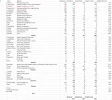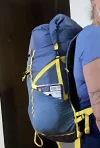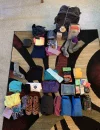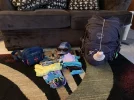Peacemaker
Member
- Time of past OR future Camino
- Future - planned for late March and April 2022
I'm in final planning for beginning the Camino Frances in early April. I've been collecting ideas about necessary equipment for the April/May shoulder season) without going overboard, and have winnowed down the gear I think will be needed. My pack weighs 21 pounds (9.5 Kilos) without the Crocs, which I'm comfortable carrying.
Here's my challenge and question. I'll be using an Osprey Atmos 50 AG pack, mostly because its comfortable and fits me well. I figured I could use the compression straps to reduce the empty space. I just packed my gear for a test run and...there is no empty space. This is basically the same list another poster shared, who said he packs it in a 28 liter pack! How is that even possible?
I'm now leaning toward replacing the rain jacket with a rain poncho, simply because it would take up less room than the rain jacket and pack cover, but that's the only change I can think of that would reduce the space required.
Any suggestions for how to pack more efficiently would be much appreciated. Here's my packing list:
Winter Camino Packing List
Osprey Atmos AG 50L backpack (with trash compactor liner bag)
In sleeping bag compartment (inside trash compactor bag)
Here's my challenge and question. I'll be using an Osprey Atmos 50 AG pack, mostly because its comfortable and fits me well. I figured I could use the compression straps to reduce the empty space. I just packed my gear for a test run and...there is no empty space. This is basically the same list another poster shared, who said he packs it in a 28 liter pack! How is that even possible?
I'm now leaning toward replacing the rain jacket with a rain poncho, simply because it would take up less room than the rain jacket and pack cover, but that's the only change I can think of that would reduce the space required.
Any suggestions for how to pack more efficiently would be much appreciated. Here's my packing list:
Winter Camino Packing List
Osprey Atmos AG 50L backpack (with trash compactor liner bag)
In sleeping bag compartment (inside trash compactor bag)
- Sleeping bag (1kg) in Ultra-Sil compression bag
- LW sleeping bag liner
- LW rain pants
- Gaiters (to use with low trail runners)
- Phone
- Wallet
- Passport
- Nudge notes & pen
- Watch
- Masks
- Glasses
- Guidebook??
- Tissue pack / wet wipes
- Sunglasses & cleaning cloth
- First aid kit
- Pack rain cover (not if poncho)
- Water bottle (Nalgene or SmartWater)
- Snacks / trail mix
- Knife (on pack shoulder strap)
- LW gloves
- Breezeo laundry soap tabs
- Kindle
- Chargers / cables
- Adapter
- Earbuds x 2
- Deodorant
- HiBAR Shampoo bar (for body & hair)
- Floss
- Toothpaste
- Toothbrush
- Mouthguard
- Razor (disposable)
- Meds
- Small comb
- Nail clippers
- Small scissors
- Chapstick
- Ear plugs
- Eye mask for sleeping
- Microfiber towel
- Underwear
- Shirt / hoody
- Pants
- Socks
- Belt
- Lone Peak all-weather mids
- Underwear x 2
- Shirts (warmth polyester long sleeves) x 1 + LW hoody
- Pants x 1
- Puffy
- LW rain shell
- Beanie & visor cap
- Buff
- WP gloves
- Socks x 3
- Altra Olympus trail runners (low, non-WP)
- Crocs (or flipflops) for shower (clipped to outside of pack)



























